Abstract
OBJECTIVES: To evaluate knowledge, perceptions and the effectiveness of different sources of information about sickle cell trait (SCT) and sickle cell disease (SCD); to determine individual knowledge of SCT status. METHODS: 28 individuals participated in three focus groups (healthcare providers, people affected by SCD or SCT, and community members). Surveyors interviewed 282 respondents within their neighborhoods. RESULTS: Common themes across the focus groups included the limited general awareness of SCD and SCT, the emphasis on the benign nature of SCT rather than on future implications, and the need for public health education campaigns about SCD and SCT involving media strategies. The majority of community survey respondents (n = 243, 86.2%) had correct general knowledge about the genetic basis and severity of SCD, but only 16% (n = 45) knew their own trait status. When respondents had received information about SCD from friends and acquaintances, they were three times more likely to know their SCT status, compared with respondents who had not received information from a personal source (p < 0.01). CONCLUSIONS: Despite a screening history in the 1970s fraught with controversy, sickle cell disease management and detection can be a model for the empowerment of communities in making informed decisions about theirs and their families' futures, given the burgeoning of genetic information.
Full text
PDF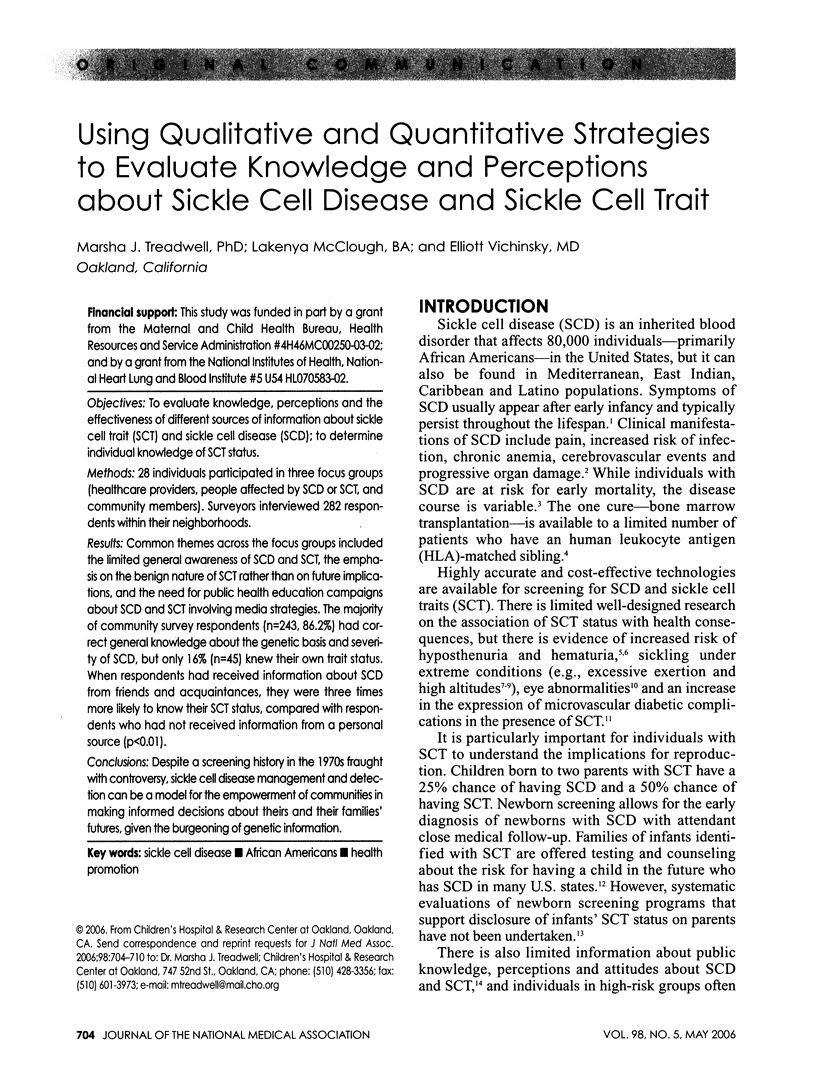
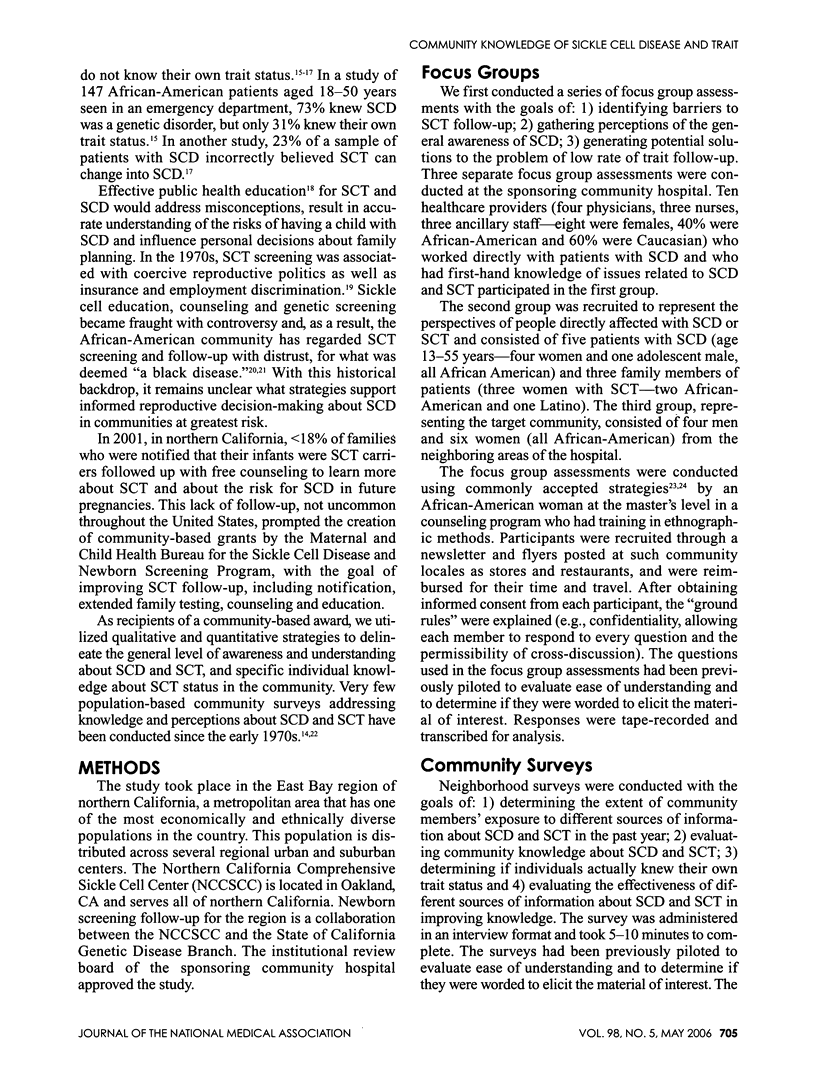
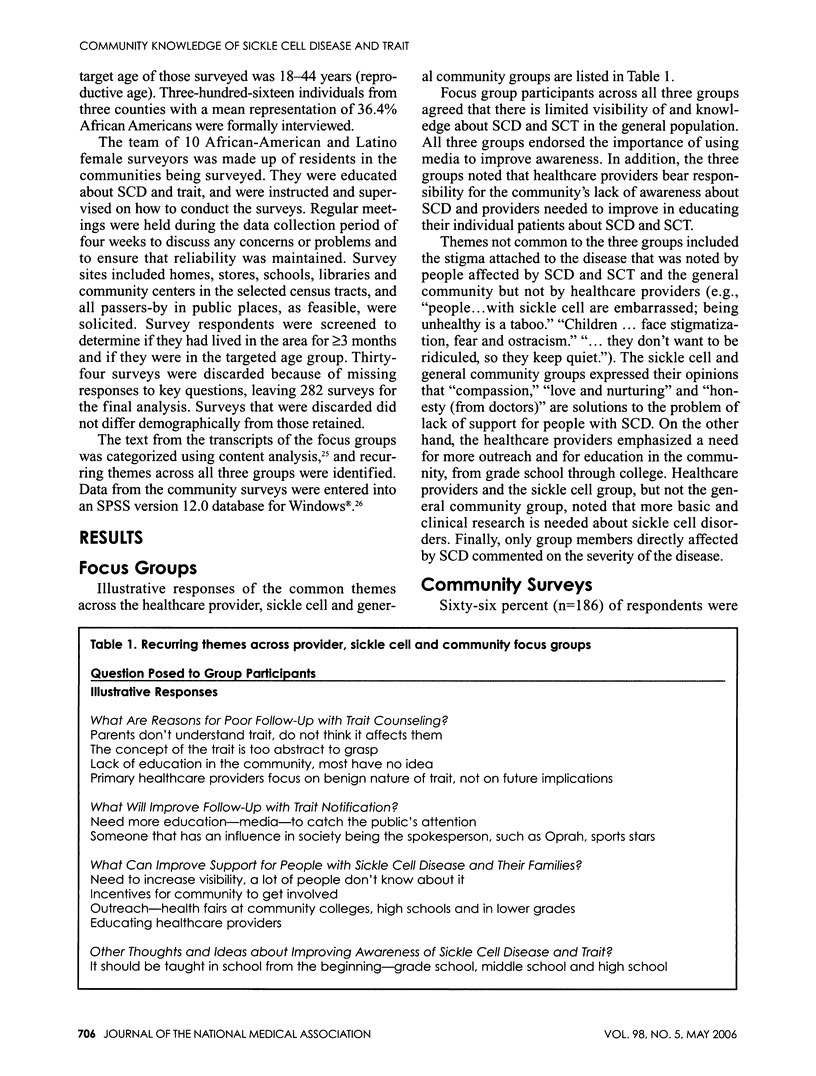
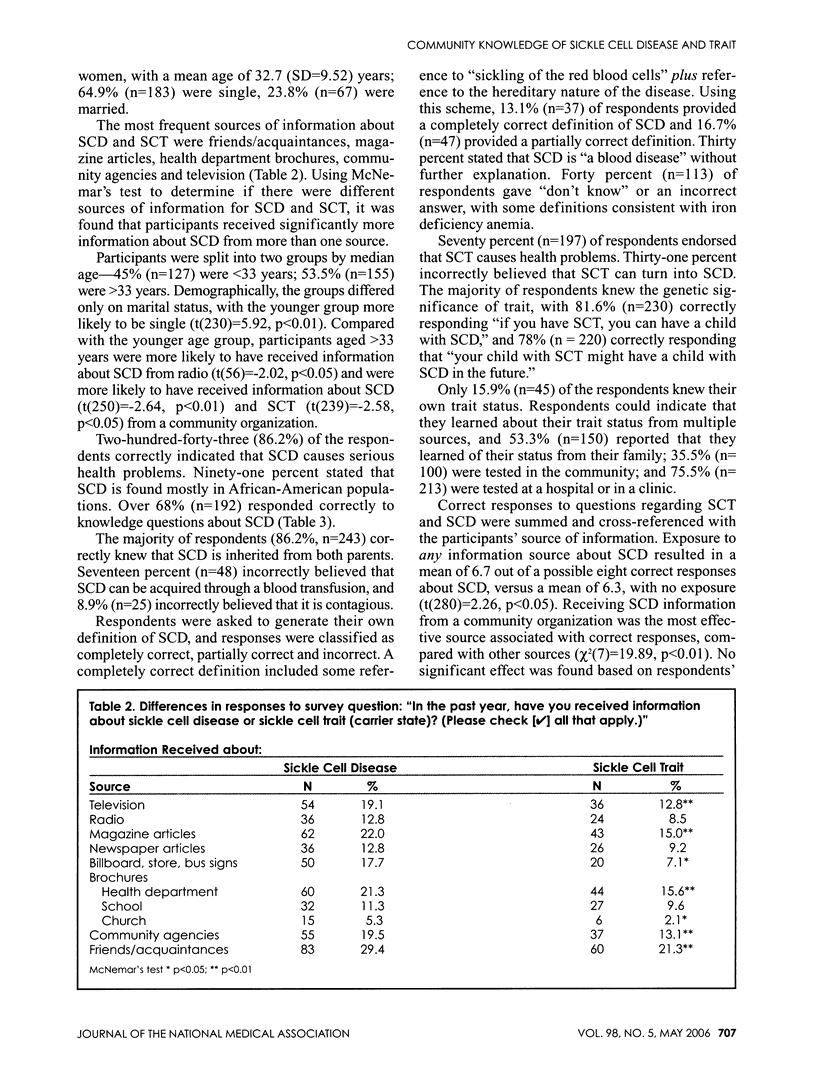
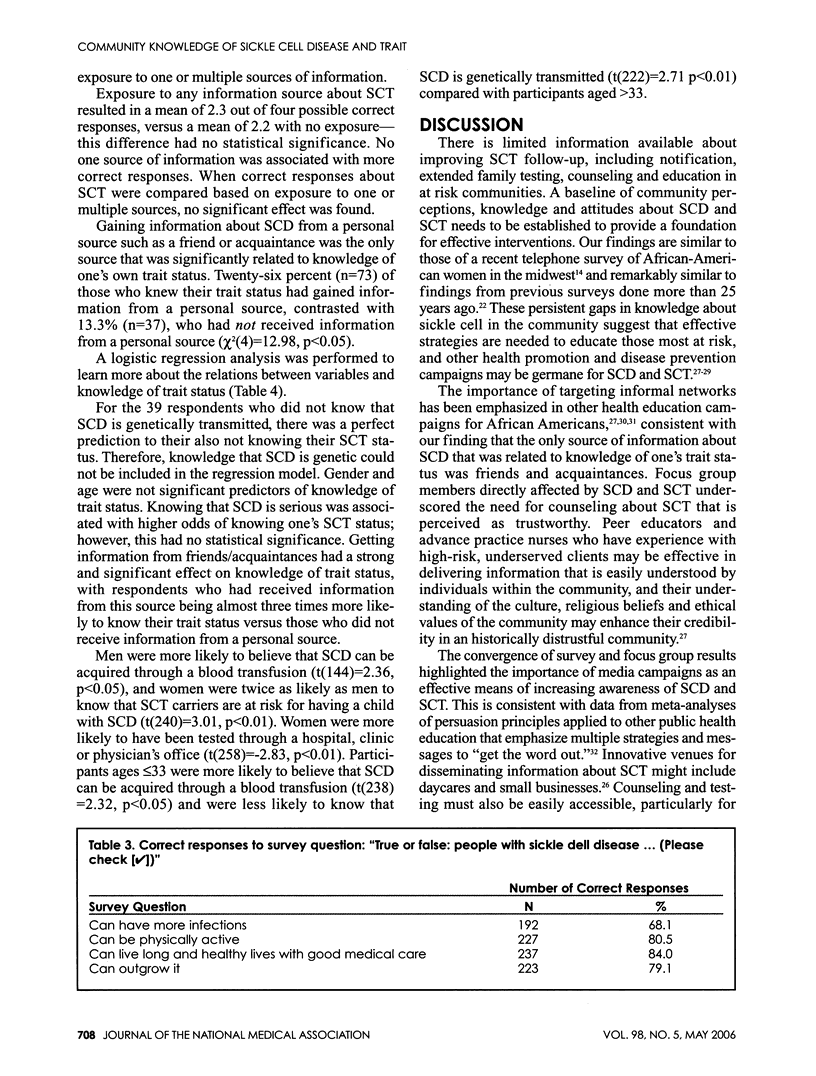
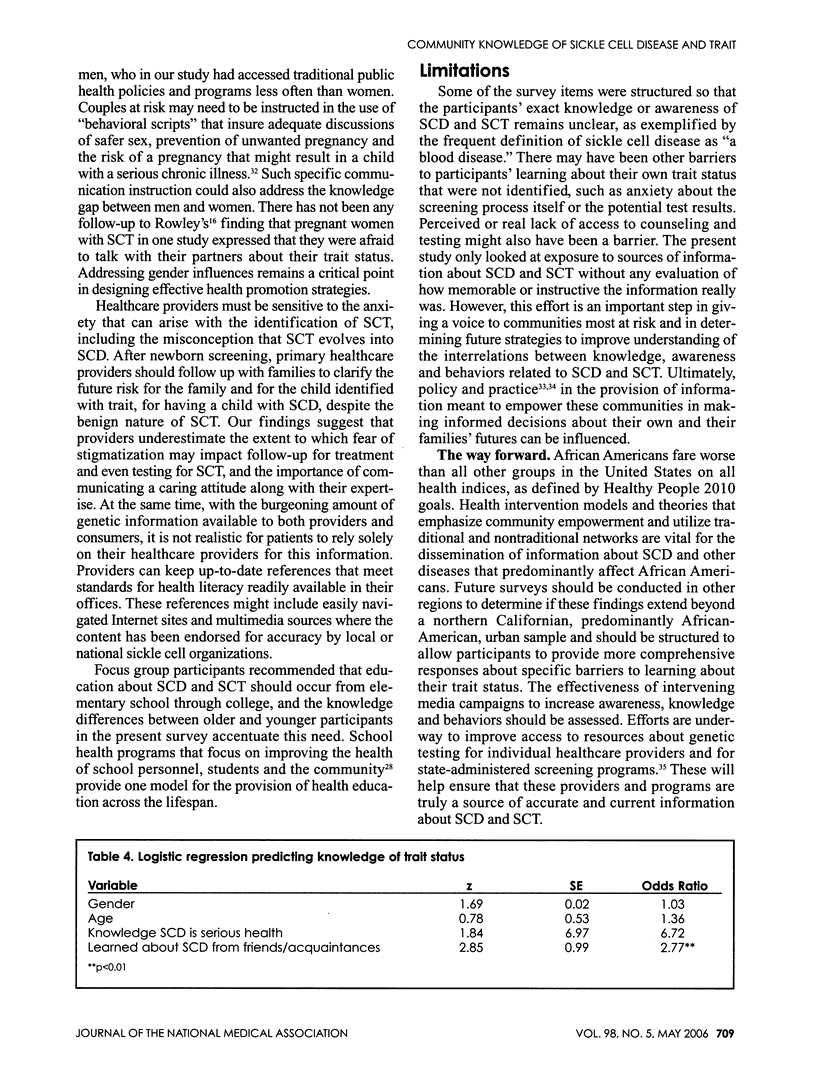
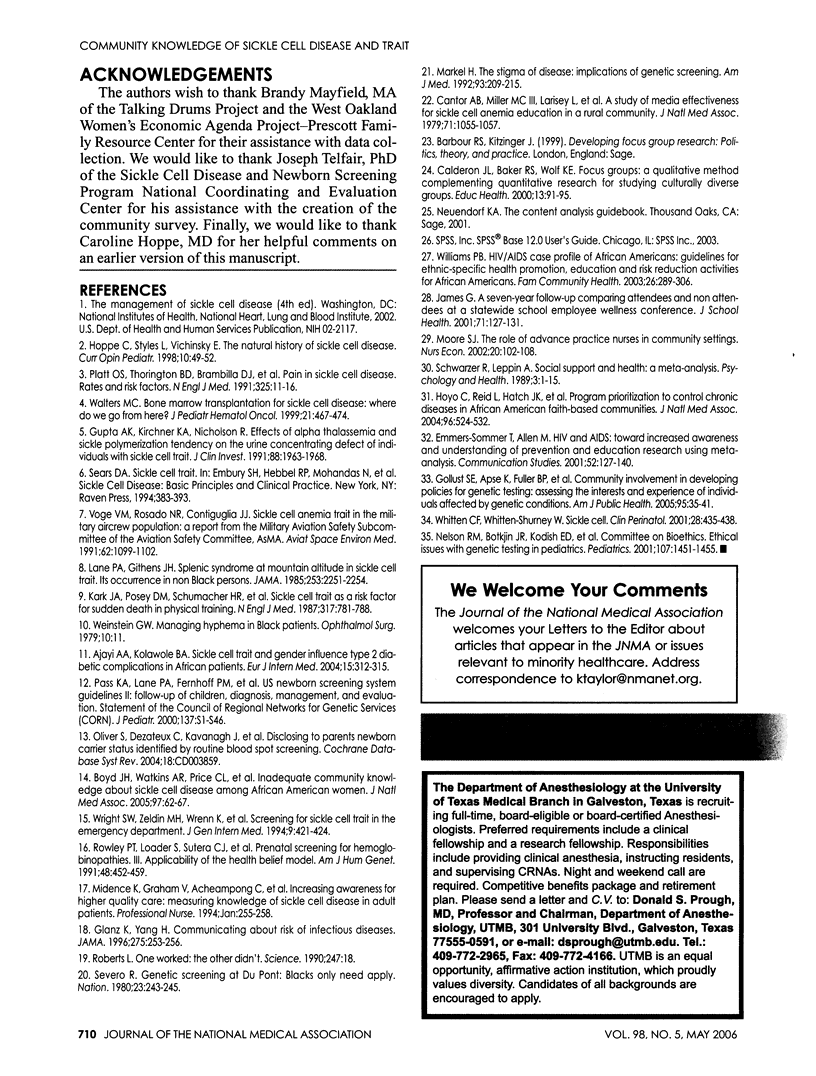
Selected References
These references are in PubMed. This may not be the complete list of references from this article.
- Ajayi A.A., Kolawole B.A. Sickle cell trait and gender influence type 2 diabetic complications in African patients. Eur J Intern Med. 2004 Aug;15(5):312–315. doi: 10.1016/j.ejim.2004.06.003. [DOI] [PubMed] [Google Scholar]
- Boyd Jessica H., Watkins André R., Price Cynthia L., Fleming Faye, DeBaun Michael R. Inadequate community knowledge about sickle cell disease among African-American women. J Natl Med Assoc. 2005 Jan;97(1):62–67. [PMC free article] [PubMed] [Google Scholar]
- Burgener Sandy C., Moore Susan J. The role of advanced practice nurses in community settings. Nurs Econ. 2002 May-Jun;20(3):102–108. [PubMed] [Google Scholar]
- Calderón J. L., Baker R. S., Wolf K. E. Focus groups: a qualitative method complementing quantitative research for studying culturally diverse groups. Educ Health (Abingdon) 2000;13(1):91–95. doi: 10.1080/135762800110628. [DOI] [PubMed] [Google Scholar]
- Cantor A. B., Miller M. C., 3rd, Larisey L., Murphy E. A study of media effectiveness for sickle cell anemia education in a rural community. J Natl Med Assoc. 1979 Nov;71(11):1055–1057. [PMC free article] [PubMed] [Google Scholar]
- Committee on Bioethics Ethical issues with genetic testing in pediatrics. Pediatrics. 2001 Jun;107(6):1451–1455. doi: 10.1542/peds.107.6.1451. [DOI] [PubMed] [Google Scholar]
- Glanz K., Yang H. Communicating about risk of infectious diseases. JAMA. 1996 Jan 17;275(3):253–256. [PubMed] [Google Scholar]
- Gollust Sarah E., Apse Kira, Fuller Barbara P., Miller Paul Steven, Biesecker Barbara B. Community involvement in developing policies for genetic testing: assessing the interests and experiences of individuals affected by genetic conditions. Am J Public Health. 2005 Jan;95(1):35–41. doi: 10.2105/AJPH.2003.025734. [DOI] [PMC free article] [PubMed] [Google Scholar]
- Gupta A. K., Kirchner K. A., Nicholson R., Adams J. G., 3rd, Schechter A. N., Noguchi C. T., Steinberg M. H. Effects of alpha-thalassemia and sickle polymerization tendency on the urine-concentrating defect of individuals with sickle cell trait. J Clin Invest. 1991 Dec;88(6):1963–1968. doi: 10.1172/JCI115521. [DOI] [PMC free article] [PubMed] [Google Scholar]
- Hoppe C., Styles L., Vichinsky E. The natural history of sickle cell disease. Curr Opin Pediatr. 1998 Feb;10(1):49–52. doi: 10.1097/00008480-199802000-00010. [DOI] [PubMed] [Google Scholar]
- Hoyo Cathrine, Reid Laverne, Hatch John, Sellers Denethia B., Ellison Arlinda, Hackney Tara, Porterfield Deborah, Page Joyce, Parrish Theodore. Program prioritization to control chronic diseases in African-American faith-based communities. J Natl Med Assoc. 2004 Apr;96(4):524–532. [PMC free article] [PubMed] [Google Scholar]
- James G. A seven-year follow-up comparing attendees and nonattendees at a statewide, school employee wellness conference. J Sch Health. 2001 Apr;71(4):127–131. doi: 10.1111/j.1746-1561.2001.tb01308.x. [DOI] [PubMed] [Google Scholar]
- Kark J. A., Posey D. M., Schumacher H. R., Ruehle C. J. Sickle-cell trait as a risk factor for sudden death in physical training. N Engl J Med. 1987 Sep 24;317(13):781–787. doi: 10.1056/NEJM198709243171301. [DOI] [PubMed] [Google Scholar]
- Lane P. A., Githens J. H. Splenic syndrome at mountain altitudes in sickle cell trait. Its occurrence in nonblack persons. JAMA. 1985 Apr 19;253(15):2251–2254. [PubMed] [Google Scholar]
- Markel H. The stigma of disease: implications of genetic screening. Am J Med. 1992 Aug;93(2):209–215. doi: 10.1016/0002-9343(92)90052-d. [DOI] [PubMed] [Google Scholar]
- Platt O. S., Thorington B. D., Brambilla D. J., Milner P. F., Rosse W. F., Vichinsky E., Kinney T. R. Pain in sickle cell disease. Rates and risk factors. N Engl J Med. 1991 Jul 4;325(1):11–16. doi: 10.1056/NEJM199107043250103. [DOI] [PubMed] [Google Scholar]
- Roberts L. One worked; the other didn't. Science. 1990 Jan 5;247(4938):18–18. doi: 10.1126/science.2294586. [DOI] [PubMed] [Google Scholar]
- Rowley P. T., Loader S., Sutera C. J., Walden M., Kozyra A. Prenatal screening for hemoglobinopathies. III. Applicability of the health belief model. Am J Hum Genet. 1991 Mar;48(3):452–459. [PMC free article] [PubMed] [Google Scholar]
- Voge V. M., Rosado N. R., Contiguglia J. J. Sickle cell anemia trait in the military aircrew population: a report from the Military Aviation Safety Subcommittee of the Aviation Safety Committee, AsMA. Aviat Space Environ Med. 1991 Nov;62(11):1099–1102. [PubMed] [Google Scholar]
- Walters M. C. Bone marrow transplantation for sickle cell disease: where do we go from here? J Pediatr Hematol Oncol. 1999 Nov-Dec;21(6):467–474. doi: 10.1097/00043426-199911000-00005. [DOI] [PubMed] [Google Scholar]
- Weinstein G. W. Managing hyphema in black patients. Ophthalmic Surg. 1979 Apr;10(4):11–11. [PubMed] [Google Scholar]
- Whitten C. F., Whitten-Shurney W. Sickle cell. Clin Perinatol. 2001 Jun;28(2):435–448. doi: 10.1016/s0095-5108(05)70095-6. [DOI] [PubMed] [Google Scholar]
- Williams P. Bassey. HIV/AIDS case profile of African Americans: guidelines for ethnic-specific health promotion, education, and risk reduction activities for African Americans. Fam Community Health. 2003 Oct-Dec;26(4):289–306. doi: 10.1097/00003727-200310000-00006. [DOI] [PubMed] [Google Scholar]
- Wright S. W., Zeldin M. H., Wrenn K., Miller O. Screening for sickle-cell trait in the emergency department. J Gen Intern Med. 1994 Aug;9(8):421–424. doi: 10.1007/BF02599054. [DOI] [PubMed] [Google Scholar]


